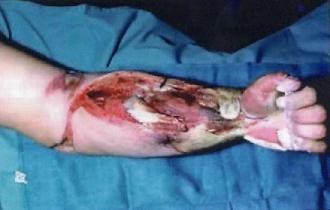An arc-flash is a release of energy caused by a flow of fault current through an electrical arc plasma. Arc flashes can occur when racking a breaker in/out, removing a bolted panel, or even simple voltage testing. Arc flash incident energies are expressed in J/cm2 or cal/cm2 at a specified work distance.
A fault current of 10kA can reach a temperature of 9000oC in 1 second. That is 6 times the melting point of iron which is 1538oC. Imagine that reaching any part of the body of a person.
Arc-flash is a workplace safety issue. NEC article 110.16 states
Electrical equipment, such as switchboards, panelboards, industrial control panels, meter socket enclosures, and motor control centers, that are in other than dwelling occupancies, and are likely to require examination, adjustment, servicing, or maintenance while energized shall be field marked to warn qualified persons of potential electric arc flash hazards. The marking shall be located so as to be clearly visible to qualified persons before examination, adjustment, servicing, or maintenance of the equipment.
FPN No. 1: NFPA 70E-2004, Standard for Electrical Safety in the Workplace, provides assistance in determining severity of potential exposure, planning safe work practices, and selecting personal protective equipment.
FPN No. 2: ANSI Z535.4-1998, Product Safety Signs and Labels, provides guidelines for the design of safety signs and labels for application to products.
Most clients are now beginning to require Electrical Engineers to do calculations to determine the incident energies.
The applicable standards for arc-flash hazards prevention are
CFR 29, 1910.132, Occupational Safety and Health Standards – Personal Protective Equipment
CFR 29, 1910.269, Occupational Safety and Health Standards – Electric Power Generation, Transmission, and Distribution
NFPA 70 (NEC) National Electrical Code
NFPA 70E-2004, Standard for Electrical Safety in the Workplace
IEEE 1584-2002, Guide for Performing Arc-Flash Hazard Calculations
OSHA states
A1910.132(d)(1) – The employer shall assess the workplace to determine if hazards are present, or are likely to be present, which necessitate the use of personal protective equipment (PPE). If such hazards are present, or likely to be present, the employer shall:
1910.132(d)(1)(i) – Select, and have each affected employee use the types of PPE that will protect the affected employee from the hazards identified in the hazard assessment.
1910.269(l)(6)(iii) – The employer shall ensure that each employee who is exposed to the hazards of flames or electric arcs does not wear clothing that, when exposed to flames or electric arcs, could increase the extent of injury that would be sustained by the employee.
NEC states
Article 110.16, Flash Protection – Switchboards, panelboards, industrial control panels, and motor control centers that are in other than dwelling occupancies and are likely to require examination, adjustment, servicing, or maintenance while energized shall be field marked to warn qualified persons of potential electric arc flash hazards.
NFPA 70E
Article 130.3, Flash Hazard Analysis- A flash hazard analysis shall be done in order to protect personnel from the possibility of being injured by an arc flash. The analysis shall determine the Flash Protection Boundary and the personal protective equipment that people within the Flash Protection Boundary shall use.
PPE Selection
Proper PPE must be selected based on both the incident energy available and the activity to be performed. An assessment of the risk and consequences is often involved.
Flash Protection Boundary
An approach limit at a distance from exposed live parts within which a person could receive a second degree burn if an arc flash were to occur.
Incident energies are primarily a function of the available fault current, the protective device clearing time, and the applicable working distance. Calculations are normally based either upon equations found in NFPA 70E-2004 or in IEEE 1584-2002. Integrated software programs that include both short-circuit calculations and relay coordination are the most effective tools for studying extensive systems.

I am amazed with it. It is a good thing for my research. Thanks